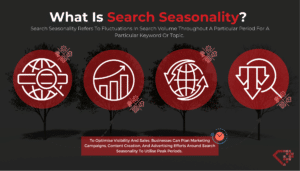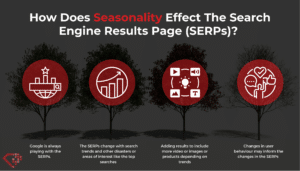[et_pb_section fb_built=”1″ _builder_version=”4.16″ global_colors_info=”{}”][et_pb_row _builder_version=”4.16″ background_size=”initial” background_position=”top_left” background_repeat=”repeat” global_colors_info=”{}”][et_pb_column type=”4_4″ _builder_version=”4.16″ custom_padding=”|||” global_colors_info=”{}” custom_padding__hover=”|||”][et_pb_text _builder_version=”4.16″ background_size=”initial” background_position=”top_left” background_repeat=”repeat” global_colors_info=”{}”]
In the dynamic world of digital marketing, understanding the impact of seasonality on Search Engine Results Pages (SERPs) is crucial for businesses looking to optimise their online presence. While most of us are familiar with the predictable seasonality trends surrounding public holidays, Christmas, and weekends, there are many other nuances of seasonal patterns that can significantly influence SERPs down to the keyword level.
In this comprehensive SEO guide, we’ll delve deeper into the concept of seasonality in business, seasonality forecasting and seasonality data analysis. By harnessing the power of tools like Google Trends, we’ll show you strategies for effectively reaching your target audience when they are most likely to search for your products or services – and finding other ways to engage with them when they aren’t.
Let’s dive in!
What is search seasonality / seasonality definition
Search seasonality refers to the fluctuations in search trends and user behaviour during specific times of the year, which can greatly impact the data we analyse on a month-to-month basis. Acknowledging and understanding seasonality is essential for businesses to successfully navigate these changing search patterns and optimise their online presence.
The significance of search seasonality lies in its ability to reveal critical insights into your target audience’s behaviour. By examining seasonality, businesses can gain insights into…
Month-on-month traffic comparisons:
Seasonality means that not every month-on-month traffic comparison will show improvement. For example, imagine a travel agency specialising in beach vacations. During the summer months, when people are more likely to search for and book beach holidays, the agency experiences a surge in website traffic.
However, as the season changes and colder weather sets in, the search volume for beach vacations typically declines, resulting in a decrease in the agency’s month-on-month website traffic.
In this case, comparing the summer months’ performance to the autumn or winter months may not provide an accurate representation of the travel agency’s overall performance. It’s essential to be aware of these variations to make informed decisions and set realistic expectations for your marketing campaigns.
Gaps in marketing strategies:
Analysing seasonality data can help identify gaps that can be closed with other types of marketing, particularly during periods when users aren’t actively searching for a product or service. This allows businesses to effectively allocate resources and develop a more comprehensive marketing strategy.
Let’s consider a garden service experiencing high demand in spring and summer, with a decline in autumn and winter, creating a gap in their marketing strategy. By analysing seasonality data, they can explore other marketing avenues during low-demand months.
They might offer winter garden maintenance services and promote them through content marketing, such as blog posts and videos with winter garden care tips or targeted email campaigns. This diversified approach helps the company maintain a consistent online presence and effectively engage with customers throughout the year, despite seasonal fluctuations in demand.
Communication of benefits to stakeholders:
Seasonality insights can be used to communicate specific benefits and opportunities to business stakeholders, allowing for better alignment of marketing objectives and company goals. Search seasonality can also inform various SEO functions, such as determining the best time to conduct a website migration (typically during quieter business periods) or A/B testing meta descriptions during busier times to gather sufficient data for meaningful results.

How does seasonality impact search engine results page (SERPs)?
Remember that Google continually adapts to changing search trends and user behaviours. Let’s explore how seasonality affects the SERPs in various ways:
- SERPs adapt to search trends: Google modifies the SERPs in response to major events, such as the COVID-19 pandemic, disasters, major news events, or areas of interest, as seen in top searches. These adjustments ensure users receive relevant and timely information during periods of heightened interest or concern.
- Seasonal trends shape SERP features: Depending on trends, Google may alter the SERPs to include more videos, images, or products. For instance, SERPs may change closer to Black Friday by displaying more Google Shopping results and ads to facilitate faster conversions. Similarly, the search term “Christmas decorations” might show images of decorations during the festive season, with an increased focus on product listings as Christmas approaches.
- SERP rankings are influenced by seasonality: Google’s primary aim is to provide users with the best possible experience through the SERPs. Consequently, changes in user behaviour due to seasonality may inform adjustments in SERP rankings. Factors such as users changing their search results or frequently returning to the SERPs after clicking on a result can trigger changes in the rankings of specific pages.
- Localised search results: Seasonality can also impact local search results, as Google may prioritise businesses or services that cater to seasonal demands in a specific region. For example, during winter, Google might display more local businesses offering heating services or winter clothing.
- Seasonal search query refinements: As users’ search queries change with seasonality, Google may refine the SERPs to better match the intent behind these queries. For instance, during summer, users may search for “best ice cream” instead of “best hot chocolate,” prompting Google to adjust the SERPs accordingly.
- Seasonal fluctuations in search volume: The search volume for specific terms or industries may increase or decrease based on seasonality, affecting the competitiveness and visibility of certain keywords. Being aware of these fluctuations can help businesses adapt their SEO strategies to maintain or improve their search rankings during peak and off-peak seasons.
- Seasonal search intent shifts: As users’ search intent changes with the seasons, Google may prioritise different types of content, such as informative articles, how-to guides, or product reviews, depending on what users are most likely to find helpful at a particular time of year.

Understand the seasonality of your target audience
To optimise your SEO strategy and marketing campaigns, it’s vital to understand the seasonality patterns of your target audience. Consider the following factors to gain valuable insights into your audience’s search behaviour:
- B2C and B2B trends: B2C search trends may be more stable, based on consumer buying patterns, whereas B2B trends can be influenced by economic factors and have more complex search trends with longer consideration periods before conversion due to multiple stakeholders involved.
- User consideration periods: Be aware of the timeframe during which users are likely to search for specific products or services. For example, a company offering skiing trips in France may experience higher search trends during summer months as people plan their skiing holidays. Understanding these patterns enables you to plan your marketing campaigns accordingly.
- Year-on-year and local seasonal trends: Examine year-on-year trends and consider local variations within a country. For instance, a company selling jerseys may see traffic increases from one part of a country before another due to different weather patterns. Another great example of this is Cape Town, which gets most of its rain during the winter months, unlike the rest of South Africa. If you’re selling umbrellas or raincoats, for instance, you’ll want to adjust your campaigns accordingly. Google Trends can be a valuable tool for assessing the seasonality of specific keywords by region.
- Changes in keyword rankings and their impact on traffic: Understand how keyword rankings affect traffic based on seasonality. For example, ranking well for “swimming costumes” in winter might not be beneficial. Identify the keywords you rank well for and close the gap using Google Ads or Microsoft Ads to feature high in the SERPs. If you’re ranking well for “swimming costumes” but not for “wool jerseys,” consider running ads for “wool jerseys” during winter because in winter “wool jerseys” will have a higher search volume, and therefore you can close the search trends gap by paying to rank high in the SERPs for “wool jerseys.”

How to Leverage Search Seasonality
So how can you use these shifts to your advantage? Here are some strategies to capitalise on search seasonality:
- Develop a seasonal content strategy: Create and promote content tailored to specific times of the year, events, or holidays. Aligning your content with seasonal trends can attract more relevant traffic and boost engagement.
- Conduct competitor analysis: Monitor your competitors’ seasonal marketing efforts to gain insights into their strategies, enabling you to identify opportunities for improvement or differentiation. This can be particularly beneficial during peak seasons when competition for search rankings and visibility is high.
- Perform seasonal keyword research: Identify and target seasonal keywords to improve your visibility in the SERPs during relevant periods. Incorporate these keywords into your content, meta tags, and ad campaigns to drive more targeted traffic to your website.
- Create seasonal promotions and offers: Leverage seasonality to develop timely promotions, discounts, or special offers catering to the needs and interests of your target audience. This can help increase conversion rates and boost customer loyalty.
- Adjust your marketing budget: Allocate your marketing budget to align with seasonal trends, ensuring you invest in campaigns that are more likely to yield results during peak periods of search activity for your industry or niche.
- Optimise your website for seasonality: Update your website’s design, layout, and navigation to reflect seasonal trends and make it easier for users to find relevant information, products, or services during peak times.
- Utilise email marketing campaigns: Send targeted email campaigns during seasonal peaks to nurture leads, promote special offers, and share valuable content that resonates with your audience’s interests at that time.
In conclusion
By recognising the impact of seasonality on search engine results pages (SERPs) and consumer behaviour, businesses can adapt their online presence and marketing efforts to align with the ever-changing landscape of search patterns.
Remember that Google continually adapts the SERPs to cater to changing search trends and user behaviours, making it essential for businesses to stay ahead of the curve. By considering factors such as localised search results, seasonal search query refinements, search volume fluctuations, and search intent shifts, businesses can create a well-rounded SEO approach that maximises their online presence during relevant periods.
If your business needs help adapting its SEO strategy to seasonal shifts in customer behaviour, Ruby Digital can provide the expertise and support you need to navigate these complex dynamics and reach your target audience effectively. Embrace the power of seasonality and harness its potential to drive your business forward!
[/et_pb_text][/et_pb_column][/et_pb_row][/et_pb_section]



